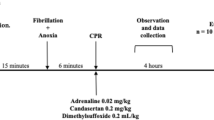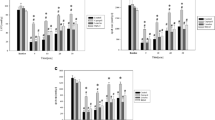Abstract
Using an isolated working heart model, we studied the effects of dopamine, adrenaline, or noradrenaline pretreatment on ischemia/reperfusion injury. Hearts from Wistar rats were perfused in the first 20-minute working mode, 15 minutes in Langendorff mode, and in the second 20-minute working mode. Hearts were treated with dopamine (0.52 and 2.60 mmol/L), adrenaline (16 and 80 nmol/L), or noradrenaline (16 and 80 nmol/L) during the second working perfusion, then arrested with St. Thomas’ Hospital cardioplegic solution and subjected to global ischemia (37°C or 20°C). During reperfusion, recoveries of cardiac function and creatine kinase leakage were measured. At 37°C, dopamine and adrenaline had a harmful effect at both doses; noradrenaline was harmful at a high dose but beneficial at a low dose. At 20°C, adrenaline, dopamine, and noradrenaline had a harmful effect at high doses but no harmful effect at low doses. To determine the role of β adrenergic stimulation before ischemia, a dose-response study was undertaken with isoprotelenol and milrinone at 37°C. Combined pretreatment with isoprotelenol and milrinone accelerated ischemia/reperfusion injury dose-dependently. Preischemic β adrenergic stimulation thus plays a significant role in the deleterious effect of catecholamine pretreatment at high doses. At low doses, however, the effect of the inotropic agent could be changed depending on ischemic temperature. Our results suggest that catecholamine should not be given at high doses before ischemia, regardless of temperature during ischemia.
Similar content being viewed by others
References
Griffith BP, Hardesty RL. Multiple cadaveric organ procurement for transplantation with emphasis on the heart. Surg Clin of N Amer 1986; 66: 451–7.
Iwai A, Sakano T, Uenishi M, Sugimoto H, Yoshioka T, Sugimoto T. Effects of vasopressin and catecholamines on the maintenance of circulatory stability in brain-dead patients. Transplantation 1989; 48: 613–7.
Yau TM, Weisel RD, Mickle DAG, Ivanov J. Cardioplegia for the dysfunctional ventricle. In: Engelman RM, Levitsky S, eds. A Textbook of Cardioplegia for Difficult Clinical Problems. New York: Futura, 1991:83–94.
Shimada Y, Yamamoto F, Yamamoto H, Oka T. The effect of preischemic catecholamine treatment on ischemia/reperfusion injury of the myocardium: Subtype, dose and temperature dependency. Jpn Cire J 1998; 62: 517–26.
Opie LH. Receptors and signal transduction. In: Opie LH, ed. The Heart. 2nd ed. New York: Raven Press, 1991: 147–75.
Hoffman B, Lefkowitz RJ. Catecholamines and sympathomimetic drugs. In: Gilman AG, Rail TW, Nies AS, Taylor P, eds. The Pharmacological Basis of Therapeutics. 8th ed. New York: McGraw-Hil, 1990: 166–86.
Hearse DJ, Braimbridge MV, Jynge P. Models and markers for the investigation of myocardial tissue damage. In: Protection of the Ischemic Myocardium: Cardioplegia. New York: Raven Press, 1981: 50–92.
Shattock MJ, Matsuura H, Hearse DJ. Functional and electrophysiological effects of oxidant stress on isolated ventricular muscle: a role for oscillatory calcium release from sarcoplasmic reticulum in arrhythmogenesis? Cardiovasc Res 1991; 25: 645–51.
Gerhardt W. Methods of Enzymatic Analysis III. 3rd ed. Weinheim: Verlag Chemie, 1983: 510–8.
Wallenstein S, Zucker CL, Fleiss JL. Some statistical methods useful in circulation research.: Circ Res 1980; 47: 1–9.
Galinanes M, Chambers DJ, Hearse DJ. Effect of sodium aspartate on the recovery of the rat heart from long-term hypothermic storage. J Thorac Cardiovasc Surg 1992; 103: 521–31.
Akera T. Pharmacological agents and myocardial calcium. In: Langer GA, ed. Calcium and the Heart. 1st ed. New York: Raven press, 1990: 299–331.
Katz AM. Receptors, coupling proteins, and second messengers. In: Katz AM, ed. Physiology of the Heart. 2nd ed. New York: Raven Press, 1992: 274–302.
Szilvassy Z, Ferdinandy P, Bor P, Jakab I, Lonovics J, Koltai M. Ventricular overdrive pacing-induced anti ischemic effect: a conscious rabbit model of preconditioning. Am J Physiol 1994; 266: H2033–41.
Vegh A, Szekeres L, Parratt JR. Transient ischemia induced by rapid cardiac pacing results in myocardial preconditioning. Cardiovasc Res 1991; 25: 1051–3.
Taylor CW, Merrit JE. Receptor coupling to polyphosphoinositide turnover: parallel with the adenylate cyclase system. Trends in Pharmacol Sci 1986; 7: 238–42.
Karmazyn M, Moffat MP. Na+/H+ exchange and regulation of intracellular Ca2+ (letter). Cardiovasc Res 1994; 27: 2079–80.
Iwakura K, Hori M, Watanabe Y, Kitabatake A, Cragoe EJ, Jr., Yoshida H, et al. αl-adrenoreceptor stimulation increases intracellular pH and Ca2+ in cardiomyocytes through Na+/H+ and Na+Ca2+ exchange. Eur J Pharmacol 1990; 186: 29–10.
Yasutake M, Ibuki C, Hearse DJ, Avkiran M. Na+/ H+ exchange and reperfusion arrhythmias: protection by intracoronary infusion of a novel inhibitor. Am J Physiol 1994; 267: H2430–40.
Shimada Y, Hearse DJ, Avkiran M. Impact of extracellular buffer composition on cardioprotective efficacy of Na+/H+ exchanger inhibitors. Am J Physiol 1996; 270: H692–700.
Seibert AF, Thompson WJ, Taylor A, Wilborn WH, Barnard J, Haynes J. Reversal of increased microvascular permiability associated with ischemia-reperfusion: Role of cAMP. J Appl Physiol 1992; 72: 389–95.
Kennedy TP, Michael JR, Hasty D, Sciuto AM, Hopkins C, Lazar R, et al. Dibutyryl cAMP, amino-phylline, and beta-adrenergic agonists protect against pulmonary edema caused by phosgene. J Appl Physiol 1989; 67: 2542–52.
Tranum-Jensen J, Janse MJ, Fiolet JWT, Krieger WJG, d’Alnoncourt CN, Durrer D. Tissue osmolality, cell swelling, and reperfusion in acute regional myocardial ischemia in the isolated porcine heart. Circ Res 1981; 49: 364–81.
Rubboli A, Sobotka PA, Euler DE. Effect of acute edema on left ventricular function and coronary vascular resistance in the isolated rat heart. Am J Physiol 1994; 267: H1054–61.
Yeh T, Parmar JM, Rebeyka IM, Lofland GK, Allen EL, Dignan RJ, et al. Limiting edema in neonatal cardiopulmonary bypass with narrow-range molecular weight hydroxyethyl starch. J Thorac Cardiovasc Surg 1992; 104: 659–65.
Warren JB, Wilson AJ, Loi RK, Coughlan ML. Opposing roles of cyclic AMP in the vascular control of edema formation. FASEB J 1993; 7: 1394–400.
Musters RJ, van der Meulen ET, van der Laarse WJ, van Hardeveld C. Norepinephrine pretreatment attenuates Ca2+ overloading in rat trabeculae during subsequent metabolic inhibition: improved contractile recovery via an alpha 1-adrenergic, PKC-depen-dent signaling mechanism.: J Mol Cell Cardiol 1997; 29: 1341–54.
Cohen MV, Thornton JD, Thornton CS, Sato H, Miki T, Downey JM. Intravenous coinfusion of adenosine and norepinephrine preconditions the heart without adverse hemodynamic effects.: J Thorac Cardiovasc Surg 1997; 114: 236–42.
Winter CB, Cleveland JC, Butler KL, Bensard DB, Mitchell MB, Harken AH. Facilitative interactions between noradrenergic and purinergic signaling during preconditioning of the rat heart. J Mol Cell Cardiol 1997; 29: 163–73.
Haessler R, Kuzume K, Wolff RA, Kuzume K, Chien GL, Davis RF, et al. Adrenergic activation confers cardioprotection mediated by adenosine, but is not required for ischemic preconditioning. Coronary Artery Disease 1996; 7: 305–14.
Yamashita N, Nishida M, Hoshida S, Igarashi J, Hori M, Kuzuya T, et al. Alpha 1-adrenergic stimulation induces cardiac tolerance to hypoxia via induction and activation of Mn-SOD. Am J Physiol 1996; 271: H1356–62.
Lawson CS, Downey JM. Preconditioning: state of the art myocardial protection.: Cardiovasc Res 1993; 27: 542–550.
Downey JM, Liu GS, Thornton JD. Adenosine and the anti infarct effects of preconditioning. Cardiovasc Res 1993; 27: 3–8.
Kolocassides KG, Galiñanes M, Hearse DJ. Ischemic preconditioning, cardioplegia or both? J Mol Cell Cardiol 1994; 26: 1411–1414.
Schömig A, Richardt G. The role of catecholamines in ischemia. J Cardiovasc Pharmacol 1990; 16: S105–12.
Author information
Authors and Affiliations
Rights and permissions
About this article
Cite this article
Shimada, Y., Yamamoto, F., Yamamoto, H. et al. Is the use of catecholamine before ischemic arrest safe?. Jpn J Thorac Caridovasc Surg 47, 299–312 (1999). https://doi.org/10.1007/BF03218016
Received:
Accepted:
Issue Date:
DOI: https://doi.org/10.1007/BF03218016




